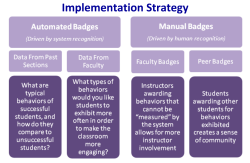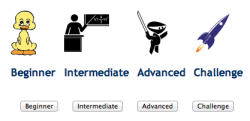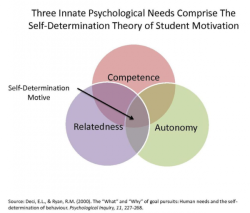In this chapter, I have add other element on designing this course:
- The summary of the chapter to learn.
- Motivation.
- Epic theme.
- Key design factor: Collaborative/Competitive; Solo/Social. and Rewards.
- Technology requierd.
fotografía de: elearningindustry.com
In this case I am both.
Design a gamified course/game project
1. Summary and game thinking.
The goal of this project, is to design an E-learning course about “digital competences”. I am going to use 2 game thinking. As a designer, my goal is that the player achieve a goal of learning “digital competences” through happiness and motivation.
-
Serious game thinking because I will alternate reality with games. That means that my design will develop real case with a bit of fiction. This means that I will need to develop a tool or find it on the Web 2.0 (open source). I will use some fiction to evaluate the student/player learning and their achievement of competence trough the course.
-
Gamification, because this course will have goals, rules and immediate feed back.
2. Type of players, analyze the core target.
Nowadays, it is really necessary for a teacher and for every one that have to work in a modern company or in any other place were it’s needed to have some digital competences. So the people that will take this course, may be come from a school, or a company business, or a government organization. It’s possible that some of them won’t be pleased to take this course because they are afraid to fail or just think that they don’t need it: this kind of student can become a Disruptor. Others one can loves it and this can be the socializer, some others was asking for it with a free spirit, and other search and find the course that they are going to take that mean that this can be an achiever, and finally we will also have the philanthropists but the main thinking is that every student, lets say player, “need to learn this competences”. So, the student goal, will be to learn, use and practice with what they will be learning.
What are they going to study?
As I write before, the goal is to create a course on digital skills facing any worker who needs it. In this case they will be teacher.
The content will be :
1-Introduction to Web 2.0 , differences and developments with Web 1.0
2 – What are social networks and virtual communities and which are their tools .
3 – Creating a social network, a virtual community. twitter , facebook , blog .
4 – What is » the cloud» and what it does.
5 – Analysis the tools available in the «cloud » .
6. Teaching Tools , E -learning, B -learning,
7 – What are virtual platforms and free sites to create courses .
8- Creating cloud content , tools to create collaborative documents.
9 – Creating a web .
10 – Final Draft , for teachers, the creation of an E-learning or B-learning course using all the tools learned.
 Infografía de: web.fhnw.ch
Infografía de: web.fhnw.ch
3. The key actions I am going to use in order to encourage the student/players to go on with the course with motivation and to engage them.
-
In the very beginning, it is necessary to think in giving the students/players an E-learning experience in order to motivate them to be engaged in the process of learning this course about “digital competence”.
-
Then it is necessary to guide them through the learning with immediate feed back to reinforce their comprehension.
-
By using some serious game thinking, we will have to provide an E-learning experience by using for example, a design quiz questionnaire, where, for every right answer the student will have a plant or a tree, and it will go on growing, but if the answer is wrong, the tree will loose it’s leafes.
-
The course will provide the player real experience, realistic practice and authentic tools and context.
-
Try to be as flexible as possible with the players needs, so in this case, the best will be the personal experience with the teacher/tutor.
Motivations: it will be an extrinsic motivation at most of the game/course, the player will deal with logic, calculation, ownership, they need to achieve goal to go on playing, using creativity.
Epic theme
Narrative that will give the player some context, at least at the begening, I mean, lets them know what kind of game they are playing and how they will solve their goal step by step, chapter after chapter. In this way I pretend to engage the player from the very beginning creating a meaningful story to give the player something in term to interacting with the learning and the other players.
 Fotografia de: www.iteachwithmoodle.com
Fotografia de: www.iteachwithmoodle.com
-
Development and accomplishment: feeling of an improving, leveling up and achieving mastery. Tracking their progress, searching to develop higher goals only by themselves.
-
Epic Meaning and calling, the player have to feel that they are unique and destined to do something really special, that they are chosen to take the special action I will design for them for step nº 1 and 2, perhaps give them in the very beginning a goal that seems very difficult and lets them to achieve it. In the next step I will introduce the other players so they will have the chance to have social influence and interaction. With this actions all the player will have the opportunity to show their skills and opinions, even the Disruptor by now will be engage to the play (course).
By using this epic theme I can begin to work on design the narrative and the goal to achieve chapter after chapter. The most important is that players cannot go further in the play with out creating assignments and being evaluate by their peer, but they can show their assignments or achieve, to the other player and be proud of it, the goal is that they have to manage the skill I propose at the beginning.
Key design factors
There are 3 main design factor, describing diferent experience to player and that will describe better the way to reach their goals.
 Fotografía de: gamificationnation.com
Fotografía de: gamificationnation.com
This can be:
-
Collaborative vs Competitive: this course/game, will begin being a “solo” game, then collaborative, in order that at the beginning the player will need to collaborate with each other to achieve almost all the course/game. One they have achieve the step nº 9, in the moment they will have to create a Web page, they will be working alone as well the step 10.
-
Solo vs social: this play/course, will take a bit of social experience, because to achieve some of the step, they will have to work with other as a team again other team, (the other half of their classmate or player. And a bit of solo player as I said before.
-
Types of rewards: it is difficult to decided what types of rewards to use in this case but it is necessary to provide the play with some of them. Thinking that the goal is to achieve digital competences, the reward can be different depending on the step of the game/course they achieve. To be effective using incentive and rewards it will be better to use a mix of reward.

-
There are other aspect to consider before giving rewards and it is: when to give it and what, thinking that we do this to motivate and engage people to our game/course with a little bit of fun, we want them to be proud of them selves. To determinate what kind of reward we can offer, is thinking the model from Gabe Zicherman, SAPS. That mean, Status, Access, Power, Stuff.
For this game I can play with the status, in chapter or step 1 and 2. from 3 to 8 with access to knowledge, and 9 and 10 with stuff, when the player will end the game/course, they probably will have a better status having some knowledge and access to a new world of new experience, that other do not have, because did not play the game/course, and the player/student perhaps, will become part of the stuff in their school in that special matter.
 Fotografía de: online.wsj.com
Fotografía de: online.wsj.com-
Technology required: This project, being an E-learning course it will use a Moodle platform, version 2.5, this special platform it has being develop perfectly well to the purpose of this game/course, it has even incorporate badges. In the other hand, every task and goal to achieve will be digital, so the game it self it will be entirely digital. To design it, a little of pen and pencil as well.
Julia Echeverría Moran



Deja un comentario